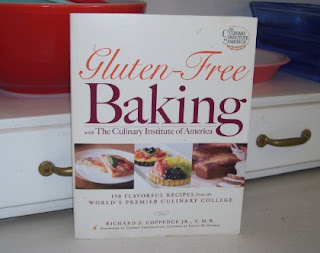Friday Book Review
This week, we'll examine another of my collection that dates from the very first days of my adopting a gluten-free lifestyle for my daughters. Gluten-Free Baking with The Culinary Institute of America, by Richard J. Coppedge, Jr., C.M.B.
The opening chapters of this book deliver an absolute wealth of information regarding adopting a gluten-free lifestyle. Everything from the biologic basis of gluten-intolerance to a description of various flours is discussed. It's clear that Chef Coppedge has taken on the challenge of a gluten-free pastry kitchen and embraced it and the community that require it. Many helpful tips are provided to ensure success, often specifically pointing out things that will differ from standard baking practices.
And then we hit the "flour blends." Chef Coppedge has designed 5 separate blends of flours from a very "weak" cake flour-type blend up through a strong, high protein blend. Unfortunately, some of these flour blends require fairly large amounts of pricey ingredients to make a relatively small amount of flour. Both albumen powder and whey powder are expensive and can be difficult to obtain. But that in and of itself does not cause me TOO much pause. After all, xanthan gum can be expensive, and the entire gluten-free lifestyle requires a commitment to spend more for similar products than a normal family would.
It's clear that Chef Coppedge approached the problem with the goal of creating products that are as close to their gluten-containing counterparts as it was within his power to create. And as a CIA Pastry Chef, those powers are pretty impressive. You can probably hear the "but" coming. "But" - successful use of this book require the reader to mix up all five of Chef Coppedge's flour blends. And then use one, two or three of the blends in each recipe, with or without straight gluten-free flours of various kinds.
I've tried a fair number of the recipes in this book and had them all come out very well. Though I can't say that I find my success to be substantially better than with other gluten-free recipes. The real fly in the ointment is that this book asks you for a commitment to Chef Coppedge's blends and methods. Either you keep all 5 blends mixed up and ready to go - probably at the expense of pantry space to keep many other gluten-free products, or you look it over and decide that it's not worth the effort. Once I ran out of one of the blends, I started reaching for other books. A few months later I dumped out two more of the blends and re-purposed their canisters for other things.
I like the book. It's full of good information and the recipes work well. But in the end, it's methodology is overly-complex and prone to cramp the style of anybody who wants to use other recipes or develop their own. If you want ONE gluten-free baking book to use exclusively - there is no better choice on the bookshelf that I've encountered. If you want a book to add to a collection and to use as a springboard to learning to convert recipes for gluten-free usage, this book would not be at the top of my list.



Comments
Post a Comment